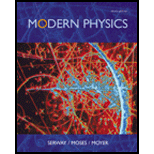
(a)
The lowest energy of the system in which electrons occupy respective state.
(a)
Answer to Problem 17P
The lowest energy of the system in which electrons occupy respective state is
Explanation of Solution
The particle placed in a cubical box is a well-known model in the field of
The particle in a box is a completely hypothetical model which illustrates the basic difference between the classical and quantum models. According to
Write the expression for the energy of the particle in cubical box.
Here,
According to Pauli Exclusion Principle, no more than two fermions can occupy same state. The electros are also fermions and are identical due to which any two electrons can occupy any state.
The electrons will, first, occupy ground state and then they will occupy further states with two electrons filled in each state.
The minimum energy of the system is the sum of energies of electrons present in ground state and other states. The electrons can also occupy the degenerate energy state due to which there can be three possible combinations, of respective
The energy of the electrons presents in the states
Write the expression for the minimum energy of the system of 8 electrons.
Simplify the above expression.
Here,
Conclusion:
Substitute
Substitute
Substitute
Thus, the lowest energy of the system in which electrons occupy respective state is
(b)
The lowest energy of the system of particles which have same mass as electrons but do not obey exclusion principle.
(b)
Answer to Problem 17P
The lowest energy of the system of particles which have same mass as electrons but do not obey exclusion principle is
Explanation of Solution
Since, the particles do not obey exclusion principle. Therefore all the particles can occupy same state that is ground state.
Write the expression for the minimum energy.
Here,
Conclusion:
Substitute
Substitute
Thus, the lowest energy of the system of particles which have same mass as electrons but do not obey exclusion principle is
Want to see more full solutions like this?
Chapter 9 Solutions
Modern Physics, 3rd Edition
- Pls help ASAParrow_forward12. A motorboat traveling 6 m/s, West encounters a water current travelling 3.5 m/s, South. a) Draw a vector diagram showing the resultant velocity, then determine the resultant velocity of the motorboat. b) If the width of the river is 112 m wide, then how much time does it take for the boat to travel shore to shore? c) What distance downstream does the boat reach the opposite shore?arrow_forwardLake Erie contains roughly 4.00⋅10114.00⋅1011 m3 of water. Assume the density of this water is 1000. kg/m3 and the specific heat of water is 4186 J/kg˚C. It takes 2.31x10^19 J of energy to raise the temperature of that volume of water from 12.0 °C to 25.8 ˚C. An electric power plant can produce about 1110 MW. How many years would it take to supply this amount of energy by using the 1110 MW from an electric power plant?arrow_forward
- Pls help ASAParrow_forwardPls help ASAParrow_forwardm m $2° 15. A truck is stopped at a red light. Once the light turns green, the truck accelerates forward at 1.75- that same instant, a car moving with a constant speed of 50 — passes the truck. a) How many seconds will it take for the truck to catch up to the car? S b) How many metres will the truck travel before it catches up to the car? Atarrow_forward
- Pls help ASAParrow_forwardI need help adding more information to my study guide. This is subject is physics My topic : Emission Spectrum Target Material I need information on this topic but make it as study guide form and make 5 questions and include the answers.arrow_forwardAn electron and a proton are each moving at 755 km/s in perpendicular paths as shown in (Figure 1). Find the magnitude of the total magnetic force that the electron exerts on the proton. Find the magnitude of the total electrical force that the electron exerts on the proton.arrow_forward
 Modern PhysicsPhysicsISBN:9781111794378Author:Raymond A. Serway, Clement J. Moses, Curt A. MoyerPublisher:Cengage Learning
Modern PhysicsPhysicsISBN:9781111794378Author:Raymond A. Serway, Clement J. Moses, Curt A. MoyerPublisher:Cengage Learning Principles of Physics: A Calculus-Based TextPhysicsISBN:9781133104261Author:Raymond A. Serway, John W. JewettPublisher:Cengage Learning
Principles of Physics: A Calculus-Based TextPhysicsISBN:9781133104261Author:Raymond A. Serway, John W. JewettPublisher:Cengage Learning University Physics Volume 3PhysicsISBN:9781938168185Author:William Moebs, Jeff SannyPublisher:OpenStax
University Physics Volume 3PhysicsISBN:9781938168185Author:William Moebs, Jeff SannyPublisher:OpenStax Physics for Scientists and Engineers with Modern ...PhysicsISBN:9781337553292Author:Raymond A. Serway, John W. JewettPublisher:Cengage Learning
Physics for Scientists and Engineers with Modern ...PhysicsISBN:9781337553292Author:Raymond A. Serway, John W. JewettPublisher:Cengage Learning College PhysicsPhysicsISBN:9781305952300Author:Raymond A. Serway, Chris VuillePublisher:Cengage Learning
College PhysicsPhysicsISBN:9781305952300Author:Raymond A. Serway, Chris VuillePublisher:Cengage Learning





